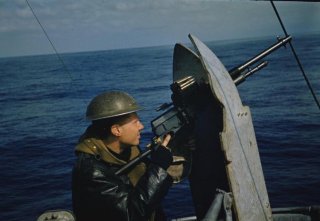The First American Light Machine Gun Was a Disaster: Meet the M1909
This gun has an innovative—if short-lived—history.
Here's What You Need to Remember: By the time World War I had come to an end, the Benét-Mercié would be mostly, if not entirely replaced in Army and Marine Corps arsenals by a variety of superior weapons, including the M1919 medium machine gun, M1918 Browning Automatic Rifle, and other European weapons like the French Chauchat.
A pair of engineers working for Hotchkiss designed a unique automatic rifle around the turn of the century. Their rifle would be known by several different names and served briefly with the United States, France, Belgium, and Britain. Though the rifle had several shortcomings, it was in essence a fairly innovative weapon. Weighing a bit more than twenty-six pounds, it was one of the lightest light machine guns then in existence, and much more portable than the heavy, crew-served weapons of the pre-World War One era.
The Benét-Mercié light machine gun, as it was known in American service, fed from thirty-round metallic ammunition strips and interestingly came with a partially finned quick-change barrel that allowed for better cooling and prolonged firing. Almost astoundingly, the United States even issued at least some Benét-Merciés with an optical sight. It had a fire selector attached to the charging handle that allowed for semi and fully-automatic fire.
Despite these features, the light machine gun suffered from accuracy problems possibly related to muzzle rise or an insufficiently robust mounting system. These issues limited the automatic gun to shorter bursts of fire and limited prolonged firing. Near the muzzle, the M1909 sported a rather unremarkable bipod, and at the rear another bipod of sorts was attached to the stock and may have made the rifle heavier and more awkward to carry, rather than aiding accuracy. In addition, the rifle’s overall performance in the field was somewhat lacking.
During combat in Mexico as part of the Pancho Villa Expedition, it was reported in American media that the machine gun had suffered mechanical setbacks. “The jamming of a machine gun at the time of the Villa raid at Columbus has been discussed among army ordnance officers as a confirmation of the decision with the past few months to displace the Benet-Mercier machine gun,” a 1916 piece in The New York Times explained. Later on during The Great War, Benét-Mercié M1909s were said to have suffered breakdowns related to broken firing pins and extractors—parts that were painstaking to replace in the field during the heat of combat.
By the time World War I had come to an end, the Benét-Mercié would be mostly, if not entirely replaced in Army and Marine Corps arsenals by a variety of superior weapons, including the M1919 medium machine gun, M1918 Browning Automatic Rifle, and other European weapons like the French Chauchat.
Still, the Benét-Mercié M1909’s distinction as the United States’ first light machine gun stands, despite the weapon’s imperfections.
Caleb Larson is a Defense Writer with The National Interest. He holds a Master of Public Policy and covers U.S. and Russian security, European defense issues, and German politics and culture.
Image: Wikimedia.

